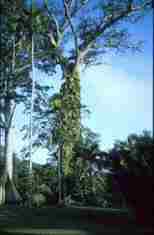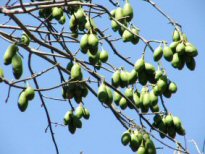|
A series of regional workshops are being held to
agree on strategies for the sustainable use of tree species
in international trade.
Biodiversity is important to humanity. Trees are specifically
exploited, due to the properties of their timber, fruit or
sap. An internationally important timber species may also
be important locally for its medicinal and cultural value.
If international demand leads to the decline of a species
in its natural habitat, the poorest of the poor are likely
to suffer.
Efforts to ensure the sustainable use of forests have generally
considered the impact of habitat destruction, rather than
species targeted for specific exploitation.
This initiative was therefore designed to identify timber
tree species in international trade, that may require targeted
concerted international action to ensure their sustainable
use.
 |
Ceiba pentandra
in Aburi Botanic Garden, Ghana.
This specimen of one of the largest
tree species in West Africa is the sole survivor of
the original forest that once covered the Aburi hills.
In addition to its value
for timber, the seed oil is used for rheumatism, the
kapok is used for surgical purposes as a substitute
for cotton wool, the seeds are eaten and the wood is
of cultural importance, being used locally for making
stools, domestic utensils, wooden figures, drums and
coffins. |
Background
details
Mesoamerican
workshop report |
|

Ceiba pentandra: recommended
by Mesoamerican workshop participants for regional action
Used internationally in large quantities,
especially for plywood and veneers. It was considered difficult
to assess trade levels and was not known to be included in
any repopulation programmes.
- The first workshop, for Mesoamerica, was held in Nicaragua
in 2005, funded by the governments of the Netherlands and
the United Kingdom.
- 18 species in international trade of conservation concern
were identified
- 4 species were recommended for consideration by the CITES
Plants Committee
- 14 species were considered to be in need of further information
and regional action
- Further workshops will be held in Africa, Asia and South
America once funding is secured.
|





